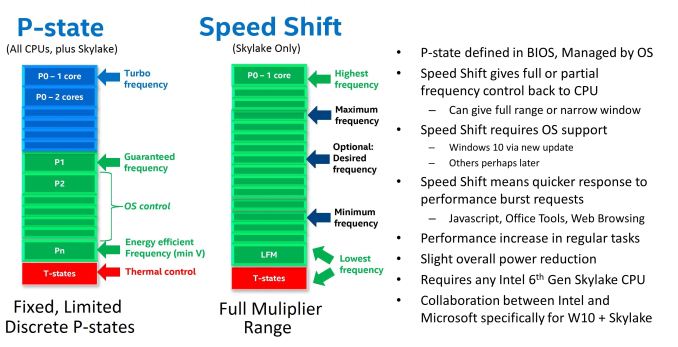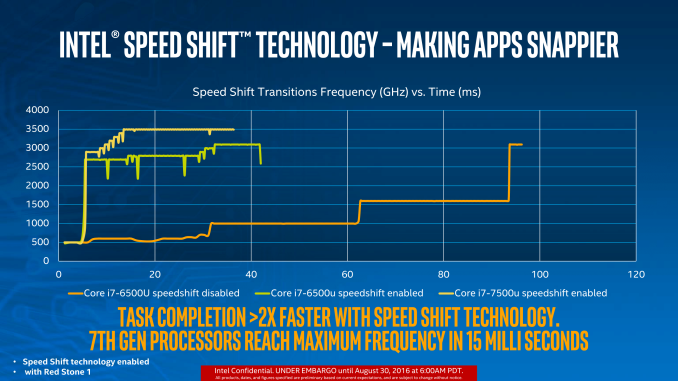The Intel Core i3-7350K (60W) Review: Almost a Core i7-2600K
by Ian Cutress on February 3, 2017 8:00 AM EST7th Generation New Features
One of the big questions regarding the launch of Intel’s 7th Generation of CPUs was around what extra features the new platform brings, especially if there isn’t any clock-for-clock performance improvement. As with our other Kaby Lake reviews, here we explain the main two: Speed Shift v2 and Optane Memory support.
Speed Shift v2
For the Intel’s 6th Generation of processors, Skylake, they introduced Speed Shift (v1). This was a feature that, at a high level, gave control of the voltage/frequency curve from the operating system to the processor. Using a series of internal metrics, such as instruction analysis and frequency, the CPU would automatically adjust the voltage and frequency of the processor as required. This afforded two major benefits: one, with the CPU in control it has access to many more points on the curve compared to the OS which is limited to specific P-states on the processor.
The second benefit is the speed of transition. A processor that can ramp up to a high frequency quickly and then drop down as needed can get through instructions quicker but also save power. Imagine driving a car, and having to wait 60 seconds to change a gear – it’s that sort of analogy.
What Speed Shift v2 does in the Kaby Lake family, compared to v1 in Skylake, is manage those transitions to higher frequency faster. Before Speed Shift, transitions from idle to peak turbo were on the order of 100 milliseconds, and Speed Shift v1 took that to 30 milliseconds (with a good base established within 15). Speed Shift v2 means that peak performance from idle now happens in 10-15 milliseconds total. This means that interactions with the OS, such as touch, or actions that rely on low latency, can occur within a couple of frames on a 60 Hz display.
The benefit of Speed Shift lies a lot in touch devices, which perhaps doesn’t affect the desktop Kaby Lake processors in this review, but also in web interactions. A lot of web work is stop and start, such as scrolling or javascript functions.
There is one caveat however – Speed Shift currently only works in Windows 10. It requires a driver which is automatically in the OS (v2 doesn’t need a new driver, it’s more a hardware update), but this limitation does mean that Linux and macOS do not benefit from it. I would be hard pressed to not imagine that Apple and Intel were not working on a macOS driver, but as yet we have not had confirmation that one exists.
Optane Memory Support
The latest memory technology to hit prime time is Intel and Micron’s 3D XPoint. This is a non-volatile form of data storage that is bit addressable and can be used as DRAM or storage. Despite being at least a decade in the making, and being formally announced in 2014, it is still yet to show up commercially as it is still being developed. Intel plans to create 3D XPoint DRAM that is slightly slower than normal DRAM but both denser (more of it) and non-volatile (keeps the data after power loss, saves power altogether), as well as 3D XPoint Storage that is faster than standard NAND flash, and more configurable. It the scheme of things, we expect the storage based products to hit the market first.
Intel, as far as we can tell, is set to release two main classes of product: Optane DRAM to be pin-compatible with DDR4 and require Optane DRAM enabled processors, and Optane SSDs which should work with any PCIe storage interface. ‘Optane Memory’ however, is something a little different. Based on pre-briefings, Optane Memory is certainly not Optane SSD we were told, but rather a storage cache for mechanical hard-drives. We’ve had this before with NAND flash drives, using Intel’s Rapid Storage Technology, and it seems that Kaby Lake and 200-series chipsets will support a new version of RST for PCIe based storage. But because this is caching drive, such as the 16GB Optane Memory drives in Lenovo’s upcoming notebooks, and not Optane SSD, might lead us to believe that ‘Optane Memory’ drives are not designed to be directly user addressable.
All that being said, Intel has stated that Optane Memory standalone drives should hit the market nearer Q3 for general consumer use, which is more in-line with what we might expect to see with Optane SSDs in the enterprise space.













186 Comments
View All Comments
BillBear - Friday, February 3, 2017 - link
For consumers who intend to purchase a discrete GPU card, it's interesting to see it confirmed that Intel could include four additional CPU cores in instead of the unnecessary (for you) integrated GPU within pretty much the exact same die size.It wouldn't cost them more to manufacture than an i7. They just want to be able to charge more money by forcing you into a different price range of product if you need many cores.
For instance: Intel’s new 10-core Core i7 Extreme Edition costs a whopping $1,723
http://www.geek.com/tech/intels-new-10-core-core-i...
fanofanand - Friday, February 3, 2017 - link
I'm not sure I agree with your assessment. Intel has a vested interest in pushing people like you into the HEDT platform which is far more profitable. If you have a powerful dGPU then you are not "mainstream" by Intel's thinking. Based on the number of computers that have no dGPU maybe they are right.BillBear - Friday, February 3, 2017 - link
You're just defending price gouging now.fanofanand - Sunday, February 5, 2017 - link
I am not defending anything, I am neither an Intel shareowner nor have they seen a penny of mine in a decade. I am saying that what they are doing makes business sense even if it doesn't suit you as well as you'd like.BillBear - Sunday, February 5, 2017 - link
For someone who frequently responds to other people's posts with silly BS like "This post brought to you by CompanyName" why are you suddenly defending price gouging on Intel's part?Price gouging makes business sense for any company. Tacking on an additional thousand dollars per part? Not really defensible.
block2 - Friday, February 3, 2017 - link
The CPU I want is one that costs me the least electricity for the 95% of the time when I'm on Facebook and surfing, yet supports Photoshop well. I bought a gold rated seasonic PSU a couple years ago and my overall power usage is very low (40w?). Really, a low end i3 ought to suffice for me. I'm still using a 2.8ghz AMD phenom II with the CPU throttling enabled (800mhz).Scipio Africanus - Friday, February 3, 2017 - link
Have you considered one of the Intel T suffix cores? They don't get a lot of coverage but give you the newest architecture with a very low TDP. The current Kaby Lake T cores are 35w TDP.The newest review i could find was for Haswell T cores:
http://www.anandtech.com/show/8774/intel-haswell-l...
Scipio Africanus - Friday, February 3, 2017 - link
It takes Intel 6 years to post 25% increase in single threaded performance? Yeesh. Competiton (read: Ryzen) can't come fast enough. My Sandy Bridge Dell Precision is staying put for a bit more.StrangerGuy - Friday, February 3, 2017 - link
And AMD did what exactly during the same 6 years? Sheesh.silverblue - Saturday, February 4, 2017 - link
Well, they've transformed a power-hungry server architecture into something that the majority of users could use in a mobile device without complaining about power or performance. I'm also pretty sure that if they had commissioned Zen even before Bulldozer's release, we still wouldn't have seen anything until recently. I'm not going to defend them for Bulldozer, but it was either trash it and work on a replacement with no money coming in or at least try to fix its problems with power, L1 and decoder, and redesign the FPU. A 25%+ IPC boost from Bulldozer to Excavator, despite the loss of L3, would have been much better received had Bulldozer been better to begin with. That's what AMD have been doing.